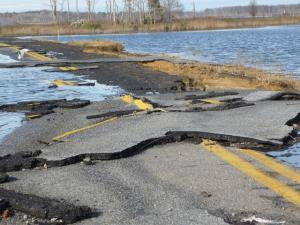Storm demonstrates vulnerability of Primehook Beach
It's a story that has been repeated so many times, Primehook Beach residents are losing count. With each storm, the small community's vulnerability only increases.
As Hurricane Sandy churned off the coast, water and mud from the marshes of Prime Hook National Wildlife Refuge washed into the community, causing flooding from 18 inches to as much as 3 feet in areas bordering the marsh. Many homes were damaged; some for the second or third time.
The marsh, which once provided flood protection to Primehook Beach, has been destroyed by saltwater intrusion from Delaware Bay water that flows through a series of breaches along nearby Fowler Beach. The storm only made the breaches wider. Ironically, serious flooding occurred in the same area almost a year ago to the day – not during a storm but during a rare high tide.
The breaches extend 4,000 feet along the shoreline. With each new storm, more sand erodes away.
To make matters worse, a nor'easter pounded the coastline Nov. 7.
During Hurricane Sandy, Prime Hook Road, the only public access to the small town, was flooded and impassable even before an evacuation order was issued. After repairing more than 1,000 feet of the road, it was reopened Nov. 3. Even so, state transportation officials say the road is very vulnerable to high tides.
During the previous week, residents could access their community only via a private road through Broadkill Beach and the Back Bay Cove community to Primehook Beach.
State transportation officials worked out a temporary easement with the Layton Family Trust and the homeowners association to provide access for $600 per day. Under terms of the agreement, DelDOT staff manned the gate at the entrance of the community 24 hours a day to check identities; only residents, service trucks and delivery trucks were able to use the road.
It was the second time in as many years such an agreement has been in place.
Cindy Miller, chairperson of the Primehook Beach Organization, was at a loss for words. “It's the same, old story,” she said, stressing the word “old.”
“Primehook Beach needs short-term help,” Miller said. Residents want the breaches filled in and dune line repaired to help stop the flow of water that floods their homes.
It's not something she hasn't said before – many times. “We need help to counteract the effects of the management of the refuge. We need federal intervention on our behalf; we can't do it on our own,” she said.
Over the summer, residents testified during a series of public hearings on a proposed comprehensive conservation plan for the wildlife refuge. Until the plan is approved by the U.S. Fish & Wildlife Service, no work can be done to address environmental issues plaguing the refuge. Officials say the plan will be approved by the end of this year.
However, filling in all of the numerous breaches to stop the flow of Delaware Bay water into the marshes is not an alternative preferred by refuge officials.
The breaches, which have now become inlets, occurred during a series of storms over the past three years. Residents of the 200-home community have been working to get the dune line rebuilt with no success.
In a letter to Gov. Jack Markell, resident Claudine Bodin pleaded for help. “The hurricane widened the breaches, bayfront homes are on the verge of collapse, Primehook Road was ripped to pieces and marshside owners are in the same mess they have been in for years since the breaches began,” she wrote.
“When I purchased property in Primehook I did not think I was going to purgatory, but that is what it has felt like for the past five years. Why make us wait any longer for assistance?”
Bodine said Primehook Beach residents have been waiting years for help. She asked the governor to contact federal officials and cut the red tape to allow the state to fix the dunes and fill in the breaches.
“The sad fact is that back in 2009 for about $5,000 the breaches could have been fixed,” Miller said.
DNREC offers emergency permitting for coastal residents
Delaware coastal community homeowners whose homes were damaged in the recent storm are receiving special consideration for permitting approval, according to DNREC Secretary Collin O'Mara.
DNREC told property owners in a recent letter that staff from the Shoreline and Waterway Management Section visited coastal areas to assess storm damage as well as vulnerability to future storms, including this week's nor'easter.
DNREC will issue emergency approvals for the following:
Construction of steps to existing structures and crossovers to beach access.
Pushing of overwash sand from around structures toward the ocean or bay.
Trucking in clean beach sand for dune and beach restoration.
Trucking in fill for reconstruction of driveways.
Minor repairs to damaged existing approved bulkheads. An application for a permit must be submitted for reconstruction of destroyed bulkheads.
Repairs to utilities such as water and sewer systems.
Repairs to foundations of existing structures.
Securing of damaged structures above the first living floor. If outer walls need to be replaced, they must be replaced back to the original state. For repairs to enclosures below the first living floor an application for a letter of approval permit is required.
Repair work at or above the lowest living floor and within the outer dimensions of a structure and repairs or replacement of siding, shingles, roofs and railings on decks and steps do not require approval.
Even though DNREC will issue emergency approvals, homeowners can't begin work without first contacting DNREC. Homeowners were told to call DNREC at 302-739-9921 for more information.




























































